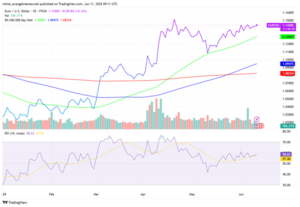Interest in the Emerging Market (EM) region has increased in 2025. Their valuations remain low, but recent growth trends and external risks (like currency instability) have shifted the perspective. We analyse the fundamentals, examine current economic indicators, and determine if EMs represent genuine undervalued opportunities or potential pitfalls.
Valuations: Attractive but Not a Free Lunch
Valuation ratios like P/E and P/B tell investors how much they’re paying for earnings or company assets.
- MSCI Emerging Markets: P/E ~14.42, P/B ~1.81
- MSCI World (developed markets): P/E ~22.46, P/B ~3.49
The data indicates that EM equities are more affordable than other investment options. The discount may represent a value opportunity, but it could also reflect ongoing political risks and poor governance practices. Not all EMs behave the same: India’s P/E is over 22 (~26.46), reflecting stronger investor confidence, while others remain deep-value plays.
Growth Momentum: Picking Up with Caveats
Earnings growth is a critical ingredient in validating today’s low valuations across emerging markets. After a stretch of underperformance, expectations for 2025 are improving. Analysts forecast that EPS for EM companies could rise by around 14% this year, notably outpacing the 8–10% projected for developed markets. This supports a forward price-to-earnings (P/E) ratio of 11-12 across many EM indices, making the case that investors are paying relatively little for future earnings potential.
That said, growth is not evenly distributed. The global PMI for emerging markets reached its lowest point since September 2024 at 51.9 in January 2025 because certain sectors showed hiring caution and reduced activity. Manufacturing activity shows positive signs while Asia leads the way as the most promising region for growth and Latin America and Eastern Europe face ongoing delays.
The takeaway: the earnings trends show positive signs but investors need to stay vigilant about potential challenges from increasing input expenses and trade-related tensions that could test the positive outlook.
Currency Risk: A Regional Watchpoint
When investing in emerging markets, it’s not just about stock performance – currencies can make or break your returns. Take 2025 so far: Brazil’s real is up nearly 14%, thanks to high local interest rates and a pause in U.S. hikes. But concerns about budget deficits still hang in the air. Over in Southeast Asia, currencies like the Malaysian ringgit and Indonesian rupiah look steady for now, helped by strong reserves and exports. Still, if the dollar strengthens, that could change fast. Eastern Europe tells a mixed story – Poland and Hungary are relatively stable, but Turkey’s lira has slid another 10% this year. And while South Africa’s rand has gained about 7%, it remains sensitive to swings in commodity prices and global risk appetite.
Bottom line: currency risk is real. It’s often overlooked – but it shouldn’t be. Keeping an eye on FX trends or spreading your exposure can help protect those EM gains.
Macro Headwinds & Policy Uncertainty
Emerging markets face mixed signals in 2025. Recent tariffs have weighed on sentiment, slowing activity in April. While the UN forecasts global growth at 2.8%, growth continues to be inconsistent. Many EM central banks could probably reduce interest rates following their previous rate hikes which could benefit markets if economic growth holds. Investors should continue to stay alert to inflation trends, trade tensions, and shifting policy paths.
Developed Markets vs. EM: A Relative View
Backed by premium valuations, developed markets offer stability. The S&P 500 trades above P/E 20, despite slower earnings growth, reflecting global investor confidence. In contrast:
- EM earnings are growing faster (+14%)
- EM valuations are cheaper (P/E ~14)
Additionally, EM funds have seen net inflows, including a surge in funds tracking MSCI Emerging Markets ex-China, even outperforming the S&P 500 in 2025 (as noted by Bank of America strategists).
Conclusion: Opportunity with Caution
Emerging markets in 2025 present a liquid value opportunity because of low valuations, improving earnings forecasts, and narratives of undervaluation supported by increasing inflows. However, the market faces ongoing challenges because economic growth is inconsistent, trade dynamics are uncertain, and currency fluctuations can hurt investment returns.
Investor strategy:
- Be selective by country – invest in EMs that have stable growth, fiscal prudence, and sound policy environments.
- Spread currency exposure across regions.
- Consider partial hedging to protect against dollar price fluctuations.
Final takeaway – For investors with a medium- to long‑term horizon and tolerance for fluctuation, emerging markets offer an appealing value play – but they're not risk-free. Remember always, discipline and diversification are essential.




